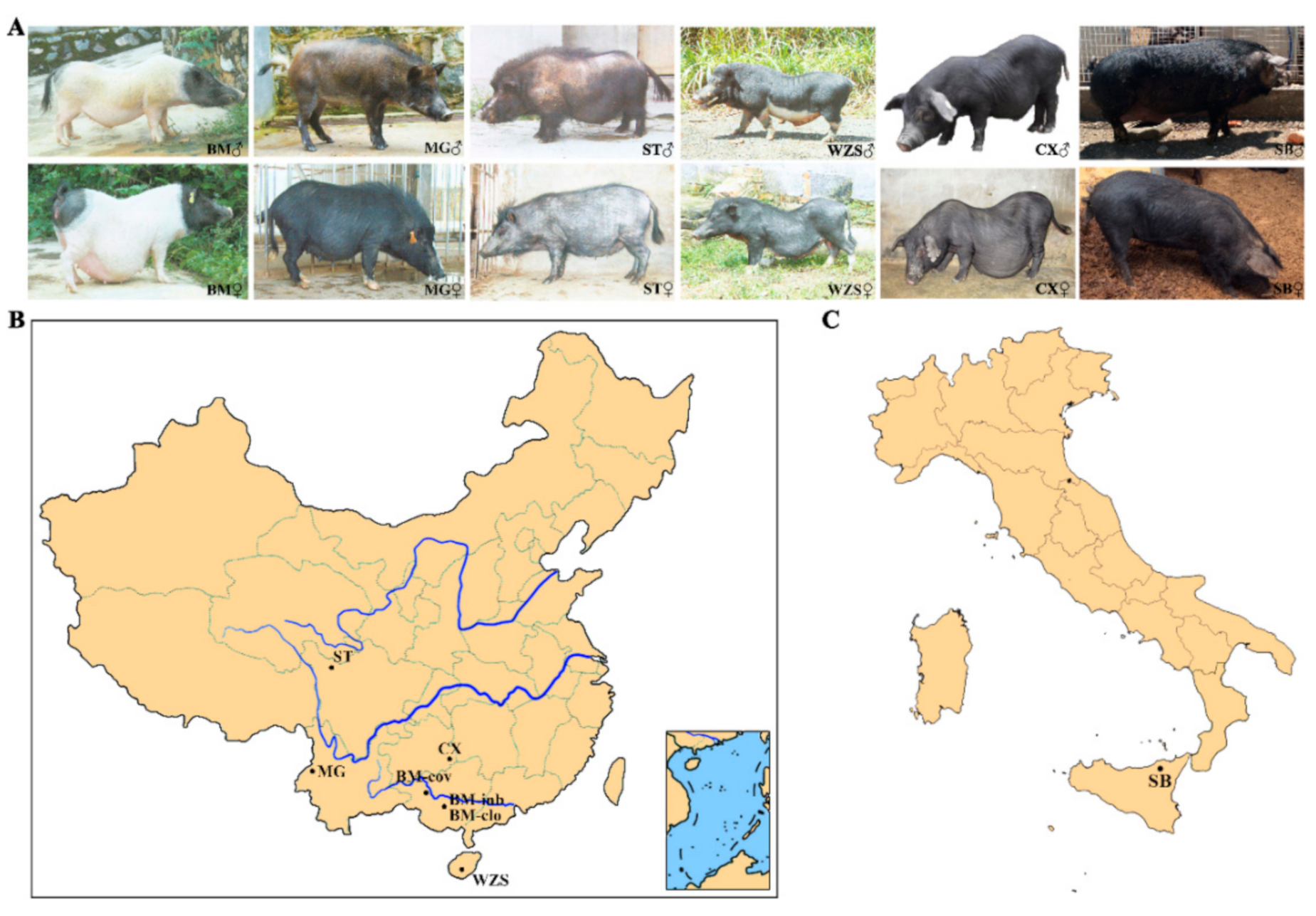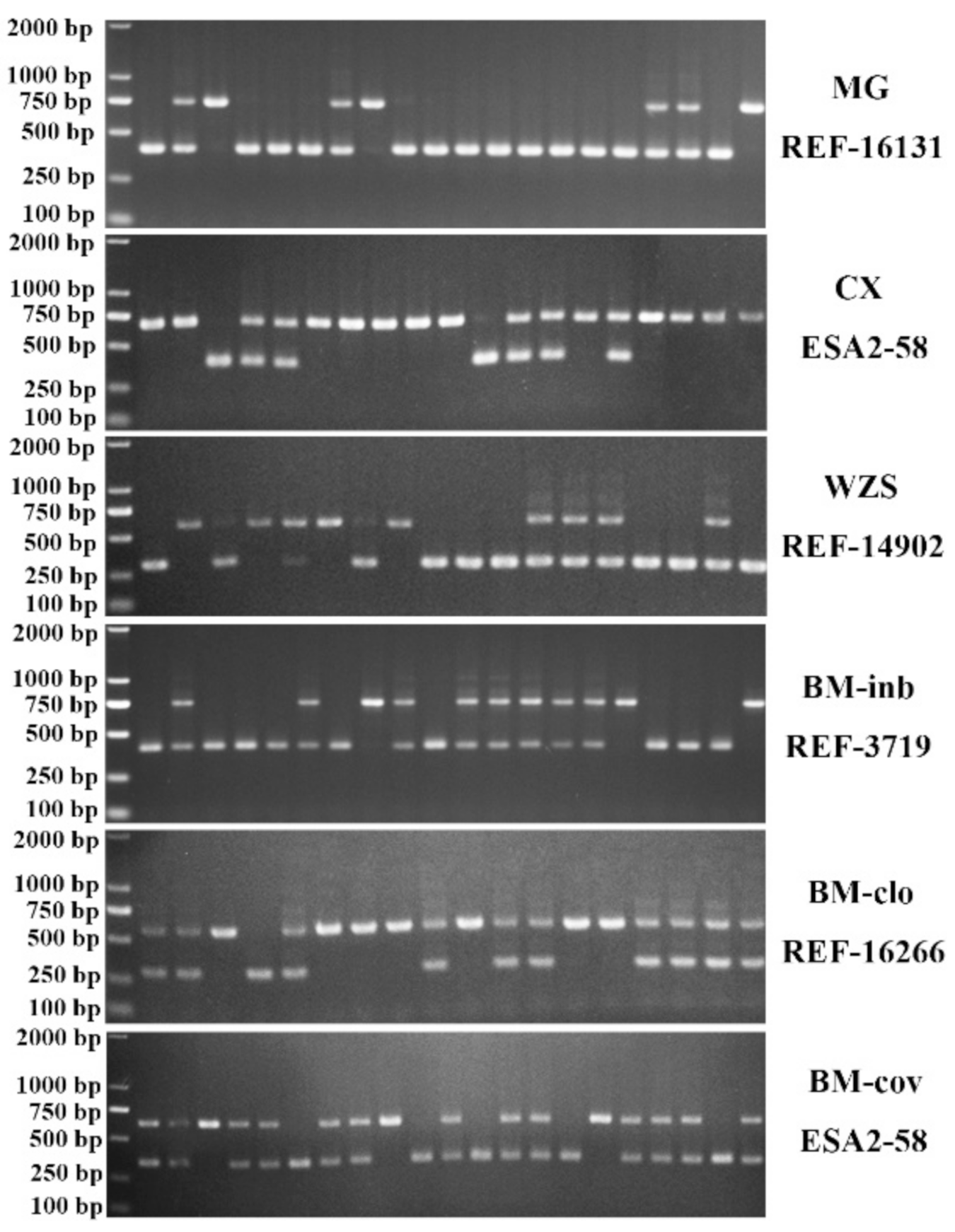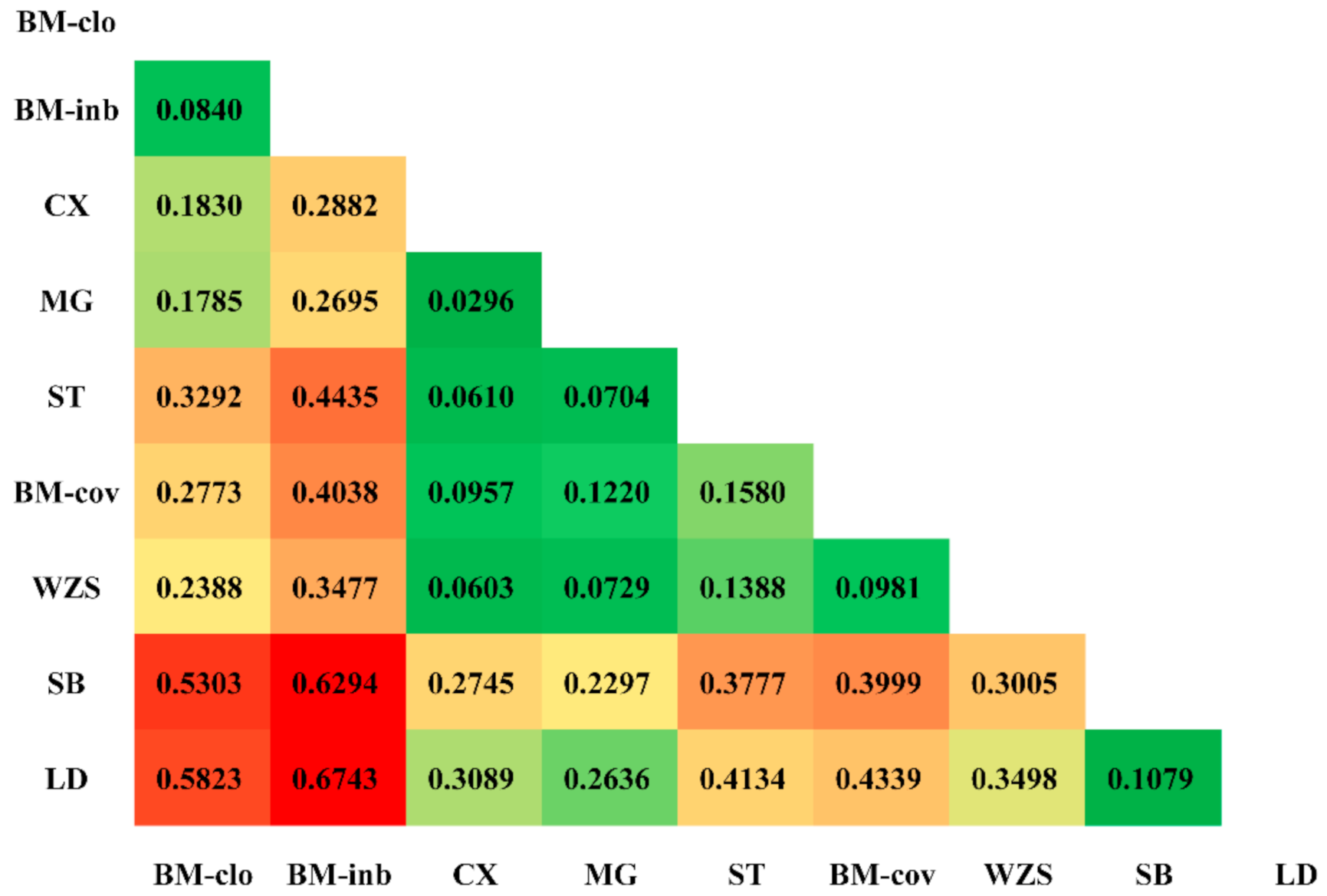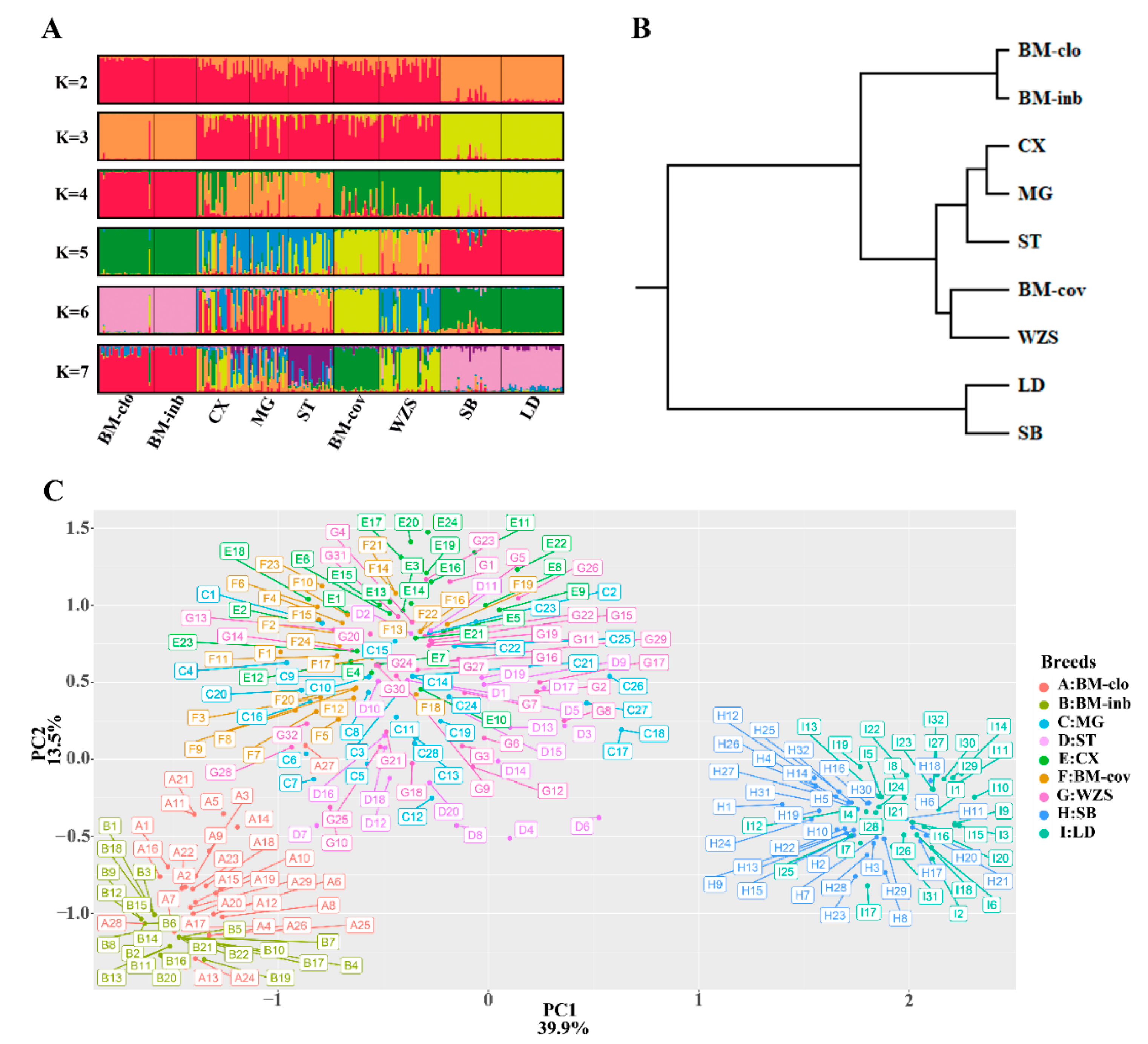Genetic Diversity and Population Structures in Chinese Miniature Pigs Revealed by SINE Retrotransposon Insertion Polymorphisms, a New Type of Genetic Markers
Abstract
Simple Summary
Abstract
1. Introduction
2. Materials and Methods
2.1. Animals and DNA Isolation
2.2. Development of RIP Makers
2.3. Statistics and Population Genetic Analyses
3. Results
3.1. Evaluation of SINE RIPs in Chinese Miniature Pig Populations
3.2. Genetic Diversity of China Miniature Pig Populations Revealed by SINE RIPs
3.3. Genetic Distances between Chinese Miniature Pig Populations Based on SINE RIPs
3.4. Population Structure of Chinese Miniature Pigs Revealed by SINE RIPs
4. Discussion
Supplementary Materials
Author Contributions
Funding
Institutional Review Board Statement
Data Availability Statement
Conflicts of Interest
References
- Bode, G.; Clausing, P.; Gervais, F.; Loegsted, J.; Luft, J.; Nogues, V.; Sims, J. The utility of the minipig as an animal model in regulatory toxicology. J. Pharmacol. Toxicol. Methods 2010, 62, 196–220. [Google Scholar] [CrossRef] [PubMed]
- Ross, J.W.; Fernandez de Castro, J.P.; Zhao, J.; Samuel, M.; Walters, E.; Rios, C.; Bray-Ward, P.; Jones, B.W.; Marc, R.E.; Wang, W.; et al. Generation of an Inbred Miniature Pig Model of Retinitis Pigmentosa. Investig. Opthalmol. Vis. Sci. 2012, 53, 501. [Google Scholar] [CrossRef]
- Wang, X.; Ou, J.; Huang, L.; Nishihara, M.; Li, J.; Manabe, N.; Zhang, Y. Genetic Characteristics of Inbred Wuzhishan Miniature Pigs, a Native Chinese Breed. J. Reprod. Dev. 2006, 52, 639–643. [Google Scholar] [CrossRef]
- De Wang, A.; Lan, G.Q.; Guo, Y.F. Genetic Breeding of Guangxi Bama Mini-pig. Lab. Anim. Sci. 2010, 1, 60–63. [Google Scholar]
- Meng, L.-J.; Wang, W.-Y.; Xu, Y.-J.; Gong, T.; Yang, Y. Postnatal differentiation and regional histological variations in the ductus epididymidis of the Congjiang Xiang pig. Tissue Cell 2020, 67, 101411. [Google Scholar] [CrossRef]
- Liu, C.; Ran, X.; Wang, J.; Li, S.; Liu, J. Detection of genomic structural variations in Guizhou indigenous pigs and the comparison with other breeds. PLoS ONE 2018, 13, e0194282. [Google Scholar] [CrossRef] [PubMed]
- Wu, Y.; Zhang, L.; Liang, J.; Jiang, Q.; Guo, Y.; Lan, G. Comparative analysis on liver transcriptome profiles of different methods to establish type 2 diabetes mellitus models in Guangxi Bama mini-pig. Gene 2018, 673, 194–200. [Google Scholar] [CrossRef]
- Lander, E.S.; Linton, L.M.; Birren, B.; Nusbaum, C.; Zody, M.C.; Baldwin, J.; Devon, K.; Dewar, K.; Doyle, M.; Fitzhugh, W.; et al. Initial sequencing and analysis of the human genome. Nature 2001, 9, 860–921. [Google Scholar]
- Groenen, M.A.M.; Archibald, A.L.; Uenishi, H.; Tuggle, C.K.; Takeuchi, Y.; Rothschild, M.F.; Rogel-Gaillard, C.; Park, C.; Milan, D.; Megens, H.-J.; et al. Pig genomes provide insight into porcine demography and evolution. Nature 2012, 491, 393–398. [Google Scholar] [CrossRef] [PubMed]
- Waterston, R.H.; Lindblad-Toh, K.; Birney, E.; Rogers, J.; Abril, J.F.; Agarwal, P.; Agarwala, R.; Ainscough, R.; Alexandersson, M.; An, P.; et al. Initial sequencing and comparative analysis of the mouse genome. Nature 2002, 420, 520–562. [Google Scholar]
- Platt, R.N.; Vandewege, M.W.; Ray, D.A. Mammalian transposable elements and their impacts on genome evolution. Chromosom. Res. 2018, 26, 25–43. [Google Scholar] [CrossRef]
- Gentles, A.J.; Wakefield, M.J.; Kohany, O.; Gu, W.; Batzer, M.A.; Pollock, D.D.; Jurka, J. Evolutionary dynamics of transposable elements in the short-tailed opossum Monodelphis domestica. Genome Res. 2007, 17, 992–1004. [Google Scholar] [CrossRef] [PubMed]
- Lindblad-Toh, K.; Wade, C.M.; Mikkelsen, T.S.; Karlsson, E.K.; Jaffe, D.B.; Kamal, M.; Clamp, M.; Chang, J.L.; Kulbokas, E.J.; Zody, M.C.; et al. Genome sequence, comparative analysis and haplotype structure of the domestic dog. Nature 2005, 438, 803–819. [Google Scholar] [CrossRef]
- Eickbush, T.H.; Malik, H.S. Origins and Evolution of Retrotransposons. In Mobile DNA II; American Society for Microbiology Press: Washington, DC, USA, 2002; pp. 1111–1144. [Google Scholar]
- Garcia-Perez, J.L.; Doucet, A.J.; Kopera, H.C.; Richardson, S.R.; Moldovan, J.B.; Moran, J.V. The Influence of LINE-1 and SINE Retrotransposons on Mammalian Genomes. Microbiol. Spectr. 2015, 3, 1–26. [Google Scholar]
- Burgess, D.J. Population genetics: Mobile elements across human populations. Nat. Rev. Genet. 2013, 14, 370. [Google Scholar] [CrossRef]
- Witherspoon, D.J.; Zhang, Y.; Xing, J.; Watkins, W.S.; Ha, H.; Batzer, M.A.; Jorde, L.B. Mobile element scanning (ME-Scan) identifies thousands of novel Alu insertions in diverse human populations. Genome Res. 2013, 23, 1170–1181. [Google Scholar] [CrossRef][Green Version]
- Flavell, A.J.; Dunbar, E.; Anderson, R.; Pearce, S.R.; Hartley, R.; Kumar, A. Ty1-copia group retrotransposons are ubiquitous and heterogeneous in higher plants. Nucleic Acids Res. 1992, 20, 3639–3644. [Google Scholar] [CrossRef][Green Version]
- Wang, W. Short interspersed elements (SINEs) are a major source of canine genomic diversity. Genome Res. 2005, 15, 1798–1808. [Google Scholar] [CrossRef]
- RAY, D.A. SINEs of progress: Mobile element applications to molecular ecology. Mol. Ecol. 2006, 16, 19–33. [Google Scholar] [CrossRef]
- Batzer, M.A.; Stoneking, M.; Alegria-Hartman, M.; Bazan, H.; Kass, D.H.; Shaikh, T.H.; Novick, G.E.; Ioannou, P.A.; Scheer, W.D.; Herrera, R.J.; et al. African origin of human-specific polymorphic Alu insertions. Proc. Natl. Acad. Sci. USA 1994, 91, 12288–12292. [Google Scholar] [CrossRef]
- Chen, C.; Wang, W.; Wang, X.; Shen, D.; Wang, S.; Wang, Y.; Gao, B.; Wimmers, K.; Mao, J.; Li, K.; et al. Retrotransposons evolution and impact on lncRNA and protein coding genes in pigs. Mob. DNA 2019, 10, 19. [Google Scholar] [CrossRef]
- Kalla, S.E.; Moghadam, H.K.; Tomlinson, M.; Seebald, A.; Allen, J.J.; Whitney, J.; Choi, J.D.; Sutter, N.B. Polymorphic SINEC_Cf Retrotransposons in the Genome of the Dog (Canis familiaris). bioRxiv 2020. [Google Scholar] [CrossRef]
- D’Alessandro, E.; Giosa, D.; Sapienza, I.; Giuffrè, L.; Cigliano, R.A.; Romeo, O.; Zumbo, A. Whole genome snps discovery in nero siciliano pig. Genet. Mol. Biol. 2019, 42, 594–602. [Google Scholar] [CrossRef] [PubMed]
- Kent, W.J. BLAT—The BLAST-Like Alignment Tool. Genome Res. 2002, 12, 656–664. [Google Scholar] [CrossRef] [PubMed]
- Altschul, S.F.; Gish, W.; Miller, W.; Myers, E.W.; Lipman, D.J. Basic local alignment search tool. J. Mol. Biol. 1990, 215, 403–410. [Google Scholar] [CrossRef]
- Yeh, F.C.; Yang, R.C.; Boyle, T. POPGENE version 1.32: Microsoft Windows–based freeware for population genetic analysis, quick user guide. Cent. Int. For. Res. Univ. Alta. Edmont. Alta. Can. 1999. Available online: https://sites.ualberta.ca/~fyeh/popgene_download.html (accessed on 15 December 2020).
- Nei, M. Genetic Distance between Populations. Am. Nat. 1972, 106, 283–292. [Google Scholar] [CrossRef]
- Kumar, S.; Stecher, G.; Tamura, K. MEGA7: Molecular Evolutionary Genetics Analysis Version 7.0 for Bigger Datasets. Mol. Biol. Evol. 2016, 33, 1870–1874. [Google Scholar] [CrossRef]
- Hubisz, M.J.; Falush, D.; Stephens, M.; Pritchard, J.K. Inferring weak population structure with the assistance of sample group information. Mol. Ecol. Resour. 2009, 9, 1322–1332. [Google Scholar] [CrossRef]
- Earl, D.A.; VonHoldt, B.M. Structure Harvester: A website and program for visualizing STRUCTURE output and implementing the Evanno method. Conserv. Genet. Resour. 2012, 4, 359–361. [Google Scholar] [CrossRef]
- Jakobsson, M.; Rosenberg, N.A. CLUMPP: A cluster matching and permutation program for dealing with label switching and multimodality in analysis of population structure. Bioinformatics 2007, 23, 1801–1806. [Google Scholar] [CrossRef]
- Rosenberg, N.A. Distruct: A program for the graphical display of population structure. Mol. Ecol. Notes 2003, 4, 137–138. [Google Scholar] [CrossRef]
- Langley, C.H.; Montgomery, E.; Hudson, R.; Kaplan, N.; Charlesworth, B. On the role of unequal exchange in the containment of transposable element copy number. Genet. Res. 1988, 52, 223–235. [Google Scholar] [CrossRef]
- Le Rouzic, A.; Capy, P. Population genetics models of competition between transposable element subfamilies. Genetics 2006, 174, 785–793. [Google Scholar] [CrossRef][Green Version]
- Flavell, A.J.; Knox, M.R.; Pearce, S.R.; Ellis, T.H.N. Retrotransposon-based insertion polymorphisms (RBIP) for high throughput marker analysis. Plant J. 1998, 16, 643–650. [Google Scholar] [CrossRef]
- Kalendar, R.; Flavell, A.J.; Ellis, T.H.; Sjakste, T.; Moisy, C.; Schulman, A.H. Analysis of plant diversity with retrotransposon-based molecular markers. Hered 2011, 106, 520–530. [Google Scholar] [CrossRef]
- Lee, J.; Mun, S.; Kim, D.H.; Cho, C.S.; Oh, D.Y.; Han, K. Chicken (Gallus gallus) endogenous retrovirus generates genomic variations in the chicken genome. Mob. DNA 2017, 8, 2. [Google Scholar] [CrossRef]
- Kalendar, R.; Schulman, A.H. IRAP and REMAP for retrotransposon-based genotyping and fingerprinting. Nat. Protoc. 2006, 1, 2478–2484. [Google Scholar] [CrossRef] [PubMed]
- Chessa, B.; Pereira, F.; Arnaud, F.; Amorim, A.; Goyache, F.; Mainland, I.; Kao, R.R.; Pemberton, J.M.; Beraldi, D.; Stear, M.J.; et al. Revealing the history of sheep domestication using retrovirus integrations. Science 2009, 324, 532–536. [Google Scholar] [CrossRef] [PubMed]
- Kamath, P.L.; Elleder, D.; Bao, L.; Cross, P.C.; Powell, J.H.; Poss, M. The Population History of Endogenous Retroviruses in Mule Deer (Odocoileus hemionus). J. Hered. 2014, 105, 173–187. [Google Scholar] [CrossRef]
- Stocking, C.; Kozak, C.A. Endogenous retroviruses: Murine endogenous retroviruses. Cell. Mol. Life Sci. 2008, 65, 3383–3398. [Google Scholar] [CrossRef]
- Wang, J.; Song, L.; Grover, D.; Azrak, S.; Batzer, M.A.; Liang, P. dbRIP: A highly integrated database of retrotransposon insertion polymorphisms in humans. Hum. Mutat. 2006, 27, 323–329. [Google Scholar] [CrossRef]
- Babatz, T.D.; Burns, K.H. Functional impact of the human mobilome. Curr. Opin. Genet. Dev. 2013, 23, 264–270. [Google Scholar] [CrossRef][Green Version]
- Giuffra, E.; Törnsten, A.; Marklund, S.; Bongcam-Rudloff, E.; Chardon, P.; Kijas, J.M.H.; Anderson, S.I.; Archibald, A.L.; Andersson, L. A large duplication associated with dominant white color in pigs originated by homologous recombination between LINE elements flanking KIT. Mamm. Genome 2002, 13, 569–577. [Google Scholar] [CrossRef]
- Sironen, A.; Uimari, P.; Iso-Touru, T.; Vilkki, J. L1 insertion within SPEF2 gene is associated with increased litter size in the Finnish Yorkshire population. J. Anim. Breed. Genet. 2012, 129, 92–97. [Google Scholar] [CrossRef] [PubMed]
- Wang, W.; Chen, C.; Wang, X.; Zhang, L.; Shen, D.; Wang, S.; Gao, B.; Mao, J.; Song, C. Development of Molecular Markers Based on the L1 Retrotransposon Insertion Polymorphisms in Pigs (Sus scrofa) and Their Association with Economic Traits. Russ. J. Genet. 2020, 56, 183–191. [Google Scholar] [CrossRef]
- Zheng, Y.; Chen, C.; Chen, W.; Wang, X.; Wang, W.; GAO, B.; Wimmers, K.; Mao, J.; Song, C. Two new SINE insertion polymorphisms in pig Vertnin (VRTN) gene revealed by comparative genomic alignment. J. Integr. Agric. 2020, 19, 2514–2522. [Google Scholar] [CrossRef]
- Fontanesi, L.; Scotti, E.; Buttazzoni, L.; Dall’Olio, S.; Russo, V. Investigation of a short interspersed nuclear element polymorphic site in the porcine vertnin gene: Allele frequencies and association study with meat quality, carcass and production traits in Italian Large White pigs. Ital. J. Anim. Sci. 2014, 13, 3090. [Google Scholar] [CrossRef]
- Liu, C.; Ran, X.; Niu, X.; Li, S.; Wang, J.; Zhang, Q. Insertion of 275-bp SINE into first intron of PDIA4 gene is associated with litter size in Xiang pigs. Anim. Reprod. Sci. 2018, 195, 16–23. [Google Scholar] [CrossRef] [PubMed]
- Smith, C.A.B. A note on genetic distance. Ann. Hum. Genet. 1977, 40, 463–479. [Google Scholar] [CrossRef]
- Botstein, D.; White, R.L.; Skolnick, M.; Davis, R.W. Construction of a genetic linkage map in man using restriction fragment length polymorphisms. Am. J. Hum. Genet. 1980, 32, 314–331. [Google Scholar] [PubMed]
- Wang, C.; Xu, L.L.; Wu, Y.H.; Du, X.Y.; Huo, X.Y.; Gao, J.; Li, Z.K.; Li, Y.C.; Chen, Z.W. Selected representative microsatellite loci for genetic monitoring and population structure analysis of miniature swine. Genet. Mol. Res. 2015, 14, 3910–3920. [Google Scholar] [CrossRef]
- Min, F.; Pan, J.; Wang, X.; Chen, R.; Wang, F.; Luo, S.; Ye, J. Biological Characteristics of Captive Chinese Wuzhishan Minipigs (Sus scrofa). Int. Sch. Res. Not. 2014, 2014, 1–9. [Google Scholar] [CrossRef]
- Yao, S.K.; Zhang, Q.; Sun, F.Z.; Liu, P.Q. Genetic diversity of seven miniature pig breeds (strains) analyzed by using microsatellite markers. Yi Chuan 2006, 28, 407–412. [Google Scholar]
- Fan, B.; Yang, S.-L.; Liu, B.; Yu, M.; Zhao, S.-H.; Li, K. Characterization of the genetic diversity on natural populations of Chinese miniature pig breeds. Anim. Genet. 2003, 34, 465–466. [Google Scholar] [CrossRef] [PubMed]
- Huang, M.; Yang, B.; Chen, H.; Zhang, H.; Wu, Z.; Ai, H.; Ren, J.; Huang, L. The fine-scale genetic structure and selection signals of Chinese indigenous pigs. Evol. Appl. 2020, 13, 458–475. [Google Scholar] [CrossRef]




| SINE RIP | Insertion Frequency | No. of Populations Show Nonpolymorphic | No. of Populations Show Polymorphic/Not Comply with the Hardy–Weinberg Equilibrium | FIS | FST | ||||||||
|---|---|---|---|---|---|---|---|---|---|---|---|---|---|
| MG | ST | WZS | CX | BM-cov | BM-clo | BM-inb | SB | LD | |||||
| REF-12270 | 0.25 | 0.19 | 0.25 | 0.43 | 0.15 | 0.00 | 0.00 | 0.52 | 1.00 | 3 | 6/0 | −0.1407 | 0.4029 |
| REF-13182 | 0.98 | 1.00 | 0.94 | 0.93 | 1.00 | 1.00 | 1.00 | 0.05 | 0.00 | 5 | 4/1 | 0.2612 | 0.8800 |
| REF-14427 | 0.65 | 0.19 | 0.30 | 0.36 | 0.00 | 0.81 | 1.00 | 0.02 | 0.00 | 3 | 6/2 | 0.1356 | 0.5287 |
| REF-16131 | 0.25 | 0.31 | 0.39 | 0.16 | 0.00 | 0.00 | 0.00 | 0.00 | 0.00 | 5 | 4/1 | 0.0255 | 0.2057 |
| REF-21609 | 0.05 | 0.00 | 0.50 | 0.18 | 0.10 | 0.17 | 0.07 | 0.00 | 0.11 | 2 | 7/1 | −0.2946 | 0.1812 |
| REF-2929 | 0.33 | 0.23 | 0.28 | 0.04 | 0.48 | 0.02 | 0.00 | 0.25 | 0.33 | 1 | 8/0 | −0.0630 | 0.1429 |
| REF-3719 | 0.10 | 0.00 | 0.00 | 0.14 | 0.19 | 0.41 | 0.32 | 0.00 | 0.00 | 4 | 5/2 | 0.2028 | 0.1856 |
| REF-4531 | 0.10 | 0.35 | 0.14 | 0.20 | 0.23 | 0.02 | 0.00 | 0.19 | 0.13 | 1 | 8/1 | 0.0242 | 0.0827 |
| REF-5597 | 0.03 | 0.02 | 0.02 | 0.07 | 0.06 | 0.00 | 0.00 | 0.06 | 0.00 | 3 | 6/0 | −0.0583 | 0.0273 |
| REF-7445 | 0.10 | 0.58 | 0.00 | 0.04 | 0.00 | 0.00 | 0.00 | 0.06 | 0.00 | 5 | 4/0 | −0.1497 | 0.4030 |
| REF-8430 | 0.03 | 0.02 | 0.13 | 0.14 | 0.56 | 0.03 | 0.00 | 0.02 | 0.33 | 1 | 8/1 | −0.1065 | 0.2665 |
| REF-9435 | 0.35 | 0.13 | 0.11 | 0.39 | 0.02 | 1.00 | 1.00 | 0.03 | 0.00 | 3 | 6/1 | −0.0393 | 0.6400 |
| REF-10096 | 0.20 | 0.21 | 0.05 | 0.16 | 0.21 | 0.00 | 0.00 | 0.20 | 0.13 | 2 | 7/1 | 0.0502 | 0.0639 |
| REF-11062 | 0.38 | 0.52 | 0.67 | 0.64 | 0.90 | 0.98 | 1.00 | 0.02 | 0.00 | 2 | 7/0 | 0.0181 | 0.5204 |
| ESA1-98 | 0.18 | 0.00 | 0.16 | 0.13 | 0.00 | 0.00 | 0.00 | 0.88 | 1.00 | 5 | 4/1 | −0.0300 | 0.7135 |
| REF-11172 | 0.25 | 0.06 | 0.28 | 0.29 | 0.21 | 0.00 | 0.00 | 0.81 | 0.91 | 2 | 7/1 | −0.1501 | 0.4540 |
| REF-13104 | 0.73 | 1.00 | 0.66 | 0.96 | 1.00 | 0.98 | 1.00 | 0.03 | 0.42 | 3 | 6/1 | −0.0407 | 0.5510 |
| REF-14902 | 0.23 | 0.27 | 0.20 | 0.16 | 0.54 | 0.03 | 0.00 | 0.02 | 0.25 | 1 | 8/0 | −0.0329 | 0.1643 |
| REF-16266 | 0.58 | 1.00 | 0.70 | 0.89 | 1.00 | 0.66 | 0.70 | 0.14 | 0.00 | 3 | 6/1 | −0.0179 | 0.4738 |
| REF-17668 | 0.50 | 0.42 | 0.75 | 0.57 | 0.81 | 0.90 | 1.00 | 0.00 | 0.00 | 3 | 6/1 | −0.3508 | 0.4746 |
| ESA2-58 | 0.80 | 0.85 | 0.59 | 0.80 | 0.46 | 0.98 | 1.00 | 0.95 | 0.75 | 1 | 8/0 | −0.0192 | 0.1813 |
| DR-93949 | 0.33 | 0.15 | 0.08 | 0.25 | 1.00 | 0.00 | 0.00 | 0.88 | 0.92 | 3 | 6/0 | −0.0583 | 0.5751 |
| ESA1-16 | 0.38 | 0.10 | 0.92 | 0.46 | 0.81 | 1.00 | 1.00 | 0.94 | 1.00 | 3 | 6/0 | −0.0558 | 0.5097 |
| REF-3992 | 0.45 | 0.81 | 0.50 | 0.55 | 0.13 | 0.00 | 0.00 | 0.20 | 0.63 | 2 | 7/1 | −0.0048 | 0.3262 |
| ESA1-25 | 0.78 | 0.96 | 0.55 | 0.77 | 0.85 | 0.29 | 0.00 | 0.73 | 0.81 | 1 | 8/1 | −0.0407 | 0.3652 |
| ESA2-18 | 0.53 | 0.52 | 0.08 | 0.32 | 0.40 | 0.57 | 1.00 | 0.58 | 0.81 | 1 | 8/0 | 0.0011 | 0.2546 |
| ESA1-33 | 0.28 | 0.00 | 0.00 | 0.14 | 0.00 | 0.12 | 0.00 | 0.53 | 1.00 | 5 | 4/0 | −0.1187 | 0.5752 |
| REF-9432 | 0.48 | 0.54 | 0.14 | 0.54 | 0.40 | 0.98 | 1.00 | 0.22 | 0.34 | 1 | 8/1 | 0.1906 | 0.3239 |
| ESA1-42 | 0.65 | 0.75 | 0.70 | 0.79 | 0.52 | 0.19 | 0.00 | 1.00 | 1.00 | 3 | 6/0 | 0.1874 | 0.4350 |
| ESA1-43 | 0.10 | 0.04 | 0.00 | 0.14 | 0.00 | 0.00 | 0.00 | 0.75 | 0.36 | 4 | 5/0 | −0.0475 | 0.4312 |
| No. of loci show nonpolymorphic | 0 | 7 | 4 | 0 | 10 | 13 | 27 | 5 | 15 | N | N | N | N |
| Breed Name | Sample Size | He | Ho | Polymorphic Information Content (PIC) | Effective Number of Allele (Ne) | Fis |
|---|---|---|---|---|---|---|
| MG | 20 | 0.3477 ± 0.1530 | 0.3550 ± 0.1997 | 0.2708 ± 0.1074 | 1.5813 ± 0.3184 | −0.0520 ± 0.2803 |
| ST | 24 | 0.2378 ± 0.1926 | 0.2431 ± 0.2021 | 0.1885 ± 0.1445 | 1.3879 ± 0.3621 | −0.0440 ± 0.1668 |
| WZS | 32 | 0.2814 ± 0.1783 | 0.2698 ± 0.1999 | 0.2238 ± 0.1319 | 1.4635 ± 0.3477 | 0.0397 ± 0.2956 |
| CX | 28 | 0.3181 ± 0.1409 | 0.3190 ± 0.1811 | 0.2543 ± 0.0975 | 1.5133 ± 0.3080 | −0.0148 ± 0.2699 |
| BM-cov | 24 | 0.2252 ± 0.1998 | 0.2097 ± 0.1974 | 0.1777 ± 0.1503 | 1.3730 ± 0.3787 | 0.0299 ± 0.2626 |
| BM-clo | 29 | 0.1179 ± 0.1705 | 0.1253 ± 0.1841 | 0.1267 ± 0.2106 | 1.1858 ± 0.3025 | −0.0174 ± 0.2803 |
| BM-inb | 22 | 0.0333 ± 0.1118 | 0.0333 ± 0.1126 | 0.0263 ± 0.0866 | 1.0542 ± 0.1884 | −0.0374 ± 0.1841 |
| SB | 32 | 0.1923 ± 0.1718 | 0.1958 ± 0.1859 | 0.1575 ± 0.1313 | 1.2955 ± 0.3136 | −0.0024 ± 0.2594 |
| LD | 32 | 0.1712 ± 0.1942 | 0.1813 ± 0.2057 | 0.1367 ± 0.1505 | 1.2780 ± 0.3427 | −0.0845 ± 0.1309 |
| Average | 27 | 0.2139 ± 0.0988 | 0.2147 ± 0.0980 | 0.1736 ± 0.0744 | 1.3481 ± 0.1649 | −0.0203 ± 0.0395 |
| Population Name | BM-clo | BM-inb | CX | MG | ST | BM-cov | WZS | SB | LD |
|---|---|---|---|---|---|---|---|---|---|
| BM-clo | - | 0.99 | 0.89 | 0.88 | 0.80 | 0.85 | 0.85 | 0.59 | 0.53 |
| BM-inb | 0.01 | - | 0.84 | 0.85 | 0.76 | 0.81 | 0.81 | 0.55 | 0.50 |
| CX | 0.12 | 0.17 | - | 0.98 | 0.96 | 0.93 | 0.95 | 0.75 | 0.72 |
| MG | 0.13 | 0.16 | 0.03 | - | 0.95 | 0.90 | 0.93 | 0.79 | 0.75 |
| ST | 0.23 | 0.27 | 0.05 | 0.06 | - | 0.89 | 0.89 | 0.68 | 0.64 |
| BM-cov | 0.16 | 0.21 | 0.07 | 0.11 | 0.11 | - | 0.93 | 0.66 | 0.63 |
| WZS | 0.16 | 0.21 | 0.05 | 0.07 | 0.11 | 0.07 | - | 0.74 | 0.69 |
| SB | 0.52 | 0.59 | 0.29 | 0.24 | 0.38 | 0.42 | 0.30 | - | 0.95 |
| LD | 0.63 | 0.70 | 0.33 | 0.29 | 0.44 | 0.46 | 0.36 | 0.05 | - |
Publisher’s Note: MDPI stays neutral with regard to jurisdictional claims in published maps and institutional affiliations. |
© 2021 by the authors. Licensee MDPI, Basel, Switzerland. This article is an open access article distributed under the terms and conditions of the Creative Commons Attribution (CC BY) license (https://creativecommons.org/licenses/by/4.0/).
Share and Cite
Chen, C.; Wang, X.; Zong, W.; D’Alessandro, E.; Giosa, D.; Guo, Y.; Mao, J.; Song, C. Genetic Diversity and Population Structures in Chinese Miniature Pigs Revealed by SINE Retrotransposon Insertion Polymorphisms, a New Type of Genetic Markers. Animals 2021, 11, 1136. https://doi.org/10.3390/ani11041136
Chen C, Wang X, Zong W, D’Alessandro E, Giosa D, Guo Y, Mao J, Song C. Genetic Diversity and Population Structures in Chinese Miniature Pigs Revealed by SINE Retrotransposon Insertion Polymorphisms, a New Type of Genetic Markers. Animals. 2021; 11(4):1136. https://doi.org/10.3390/ani11041136
Chicago/Turabian StyleChen, Cai, Xiaoyan Wang, Wencheng Zong, Enrico D’Alessandro, Domenico Giosa, Yafen Guo, Jiude Mao, and Chengyi Song. 2021. "Genetic Diversity and Population Structures in Chinese Miniature Pigs Revealed by SINE Retrotransposon Insertion Polymorphisms, a New Type of Genetic Markers" Animals 11, no. 4: 1136. https://doi.org/10.3390/ani11041136
APA StyleChen, C., Wang, X., Zong, W., D’Alessandro, E., Giosa, D., Guo, Y., Mao, J., & Song, C. (2021). Genetic Diversity and Population Structures in Chinese Miniature Pigs Revealed by SINE Retrotransposon Insertion Polymorphisms, a New Type of Genetic Markers. Animals, 11(4), 1136. https://doi.org/10.3390/ani11041136








